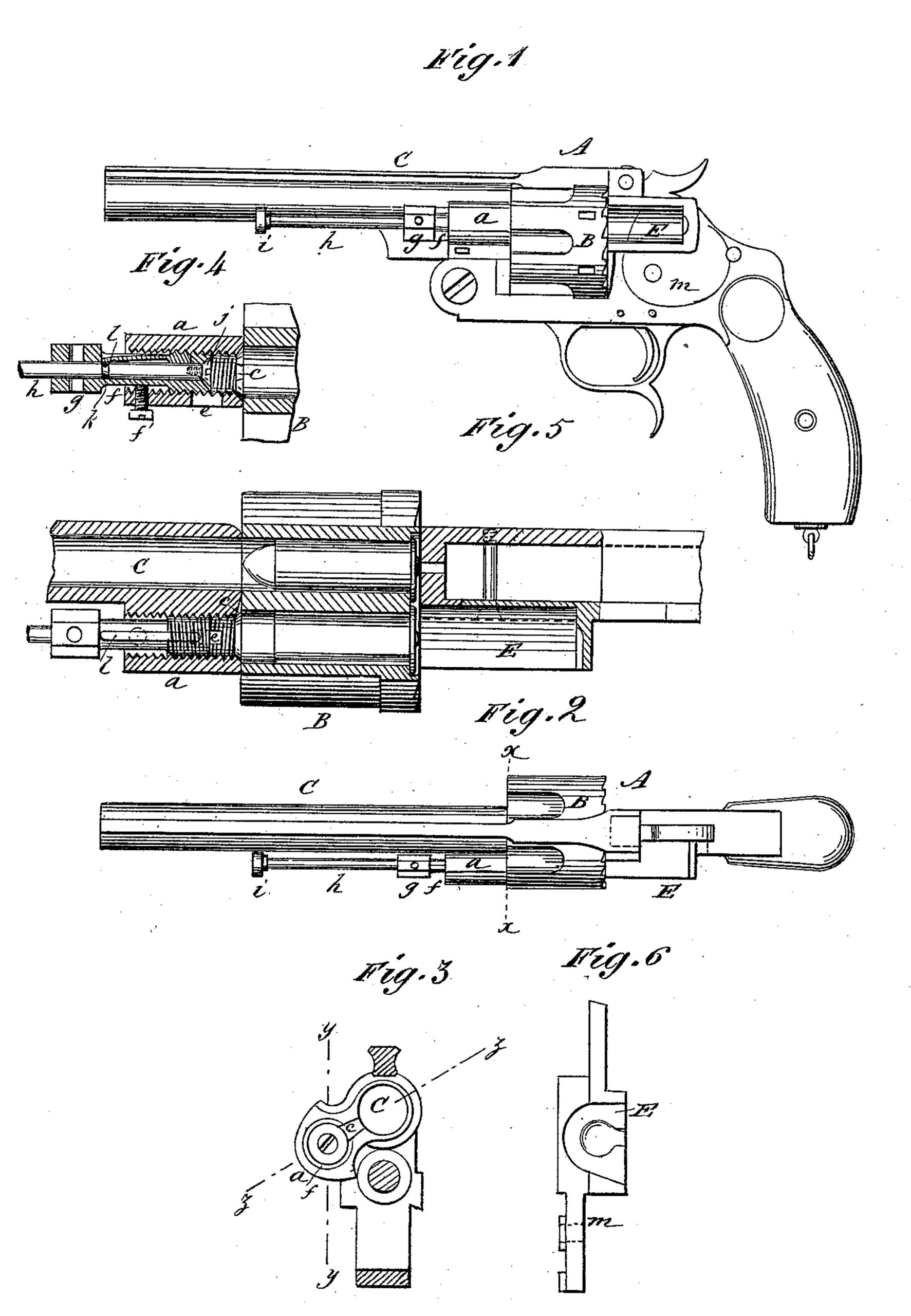US 202915
UNITED STATES PATENT OFFICE.
LUIS YBARRA, OF MADRID, SPAIN.
IMPROVEMENT IN REVOLVING FRE-ARMS.
Specification forming part of Letters Patent No. 202,915, dated April 23, 1878; application filed January 28, 1878.
To all whom it may concern:
Be it known that I, LUIS YBARRA, of Madrid, Spain, have invented a new and useful Improvement in Fire-Arms, of which the following is a specification:
Figure 1 is a side elevation of my improved fire-arm. Fig. 2 is a plan view. Fig. 3 is a transverse section taken on line x x in Fig. 2. Fig. 4 is a detail view taken in section on line y y in Fig. 3. Fig. 5 is a sectional view taken on the plane indicated by the line z z in Fig. 3. Fig. 6 is a detail view of the cartridge-guide and shell-receiver.
Similar letters of reference indicate corresponding parts.
My invention relates to revolvers; and it consists in a special chamber for receiving from the rear end of the revolver-barrel a portion of the gas resulting from the explosion of the cartridge in the revolver-cylinder, and conveying it to one of the discharged chambers of the revolver, to expel the empty cartridge therefrom.
It also consists in a device for controlling the gas-pressure in the said chamber, and in a device for expelling the cartridge or cartridge-shell when it is not desirable to discharge the revolver.
My invention further consists in a recess formed in the side of the revolver-stock, for guiding the cartridge as it is introduced into the cylinder, and for receiving the empty shells as they are expelled from the cylinder.
Referring to the drawing, A is a revolver of the ordinary form, except that the revolving cylinder B is arranged to rotate from right to left instead of the reverse, as is usual, this change being made to adapt it to my improvements, which are more conveniently placed on the left-hand side.
A chamber, a, is formed on or secured to the rear end of the barrel C, and is parallel with it. The bore of the chamber a and barrel C are separated by the same space that separates the chambers in the cylinder B; and the chamber a is arranged in relation to the barrel, so that it coincides with one of the chambers in the cylinder B when the revolver is cocked and in condition to be discharged.
The chamber a communicates with the rear end of the barrel C by means of a shallow groove, c, that is cut across that portion of the metal that separates the chamber a from the barrel C, and the chamber is provided. With a gas-escape aperture, e.
The chamber a is threaded internally to receive the tubular screw f, which is provided with a hexagonal or milled head g, for convenience in turning. This screw controls the size of the aperture e, so that more or less gas pressure may be had in the chamber a.
A rod, h, having a thumb-piece, i, is fitted in the tubular screw, and is provided with a head, j, that nearly fills the chamber a.
A circumferential groove, k, is formed in the rod h, to receive the nib formed on the end of the spring l, which is secured in a slot in the tubular screw f. By this means the rod h is prevented from being accidentally projected into the chamber a.
Behind the cylinder B, and axially in line with the chamber a, there is a hollow half-cylinder or guide, E, which is formed on or attached to the side plate m of the revolver-lock. The rear end of the half-cylinder is concaved to receive the primer of the cartridge.
The revolver is loaded by placing the cartridge in the half-cylinder or guide E and moving it forward into the cylinder B. The cylinder is then turned and another cartridge is introduced, and so on until all but the last chamber are filled. This chamber is placed opposite the chamber a, and as the revolver is discharged the gas resulting from the explosion of the cartridge forces out the shell of the cartridge previously exploded. The air contained by the chamber a and chamber in the cylinder B is also expanded by the heat, and assists in the expulsion of the shell. As the cartridge-shells are forced out in this manner cartridges are introduced, as in the first instance.
The pressure of gas in the chamber a is regulated by opening or closing the aperture e more or less by means of the screw f, and when it is desired to expel the shell or cartridge without discharging the revolver, it may be done by the rod h. The tubular screw f is prevented from turning accidentally by a binding-screw, f1.
The advantages claimed for my improvement are that it may be applied to any system of revolver, effecting a sure and quick expulsion of the shell; and the method of expulsion does not impair the shooting qualities of the revolver, as the gas is taken from the barrel after the ball has received its impulse. The firing may be more rapidly effected than in other systems, and many of the finer and more delicate parts heretofore in use for the purpose may be omitted.
Having thus described my invention, I claim as new and desire to secure by Letters Patent–
1. The combination, in a fire-arm, with the barrel C, of the chamber a, connecting with barrel by a narrow groove, c, and having the gas-escape e, as and for the purpose set forth.
2. The combination of the screw f with the chamber a, having the aperture, e, substantially as and for the purpose specified.
3. The combination of the tubular screw f and rod h with the chamber a, as shown and described.
LUIS YBARRA.
Witnesses:
JUAN BTA. ORNETA,
PEDRO DE ZUARUBRICARY.

